Nepalese vs Mexican Community Comparison
COMPARE
Nepalese
Mexican
Social Comparison
Social Comparison
Nepalese
Mexicans
1,939
SOCIAL INDEX
16.9/ 100
SOCIAL RATING
281st/ 347
SOCIAL RANK
1,179
SOCIAL INDEX
9.3/ 100
SOCIAL RATING
319th/ 347
SOCIAL RANK
Mexican Integration in Nepalese Communities
The statistical analysis conducted on geographies consisting of 24,517,450 people shows a mild negative correlation between the proportion of Mexicans within Nepalese communities in the United States with a correlation coefficient (R) of -0.365. On average, for every 1% (one percent) increase in Nepalese within a typical geography, there is a decrease of 2.272% in Mexicans. To illustrate, in a geography comprising of 100,000 individuals, a rise of 1,000 Nepalese corresponds to a decrease of 2,272.0 Mexicans.
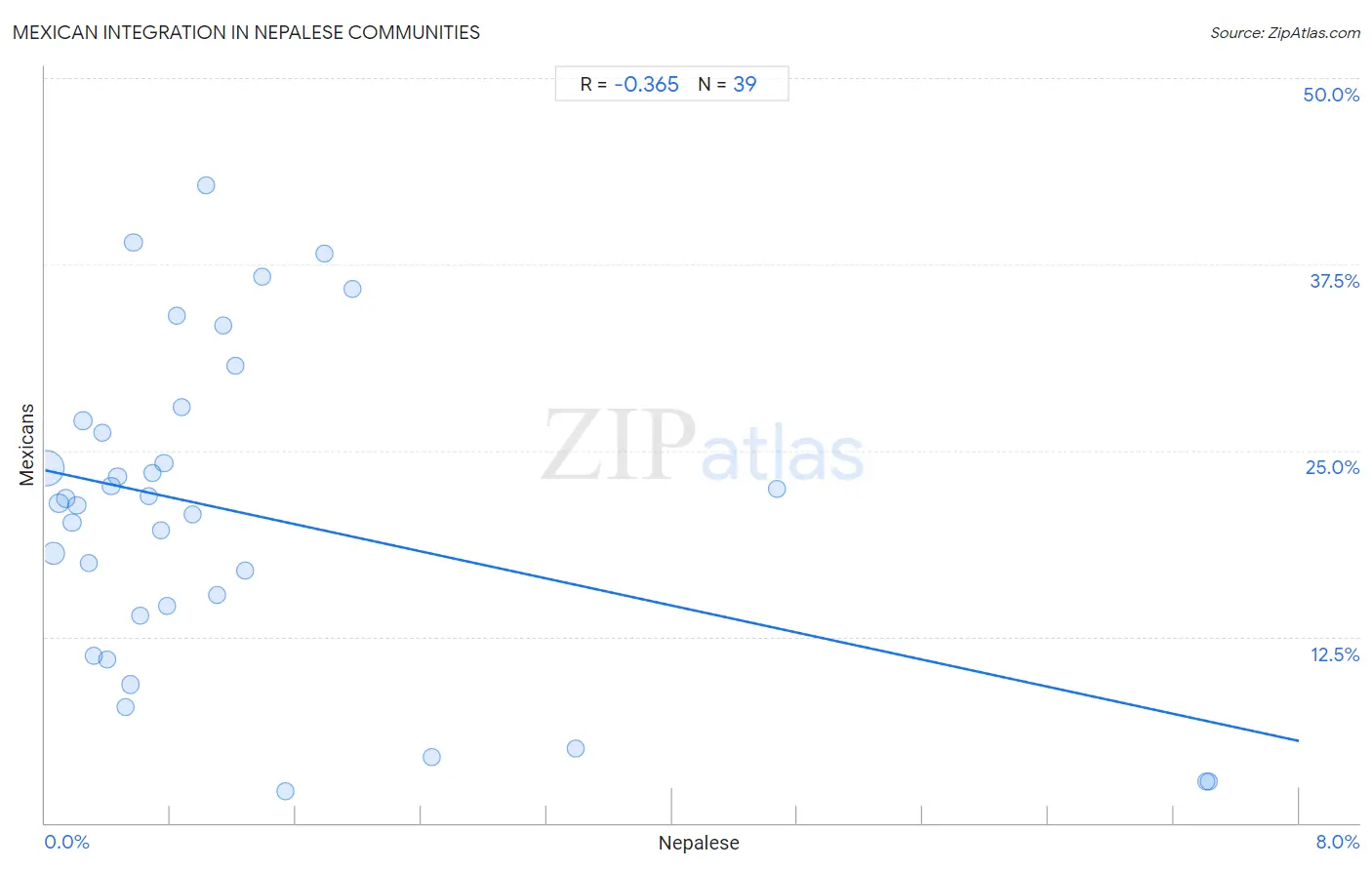
Nepalese vs Mexican Income
When considering income, the most significant differences between Nepalese and Mexican communities in the United States are seen in wage/income gap (22.2% compared to 26.0%, a difference of 17.2%), median female earnings ($38,603 compared to $33,664, a difference of 14.7%), and householder income ages 25 - 44 years ($91,498 compared to $80,427, a difference of 13.8%). Conversely, both communities are more comparable in terms of median male earnings ($49,458 compared to $46,147, a difference of 7.2%), householder income ages 45 - 64 years ($93,355 compared to $86,816, a difference of 7.5%), and householder income under 25 years ($54,472 compared to $49,989, a difference of 9.0%).

| Income Metric | Nepalese | Mexican |
| Per Capita Income | Tragic $38,442 | Tragic $34,559 |
| Median Family Income | Tragic $94,153 | Tragic $85,618 |
| Median Household Income | Poor $82,410 | Tragic $74,399 |
| Median Earnings | Tragic $43,860 | Tragic $39,834 |
| Median Male Earnings | Tragic $49,458 | Tragic $46,147 |
| Median Female Earnings | Tragic $38,603 | Tragic $33,664 |
| Householder Age | Under 25 years | Exceptional $54,472 | Tragic $49,989 |
| Householder Age | 25 - 44 years | Poor $91,498 | Tragic $80,427 |
| Householder Age | 45 - 64 years | Tragic $93,355 | Tragic $86,816 |
| Householder Age | Over 65 years | Tragic $58,761 | Tragic $53,897 |
| Wage/Income Gap | Exceptional 22.2% | Fair 26.0% |
Nepalese vs Mexican Poverty
When considering poverty, the most significant differences between Nepalese and Mexican communities in the United States are seen in single male poverty (11.6% compared to 14.0%, a difference of 20.7%), child poverty under the age of 5 (18.3% compared to 21.6%, a difference of 18.2%), and child poverty among boys under 16 (18.0% compared to 20.7%, a difference of 15.2%). Conversely, both communities are more comparable in terms of receiving food stamps (14.6% compared to 14.6%, a difference of 0.20%), female poverty among 18-24 year olds (20.2% compared to 20.5%, a difference of 1.3%), and male poverty (12.8% compared to 13.7%, a difference of 7.0%).
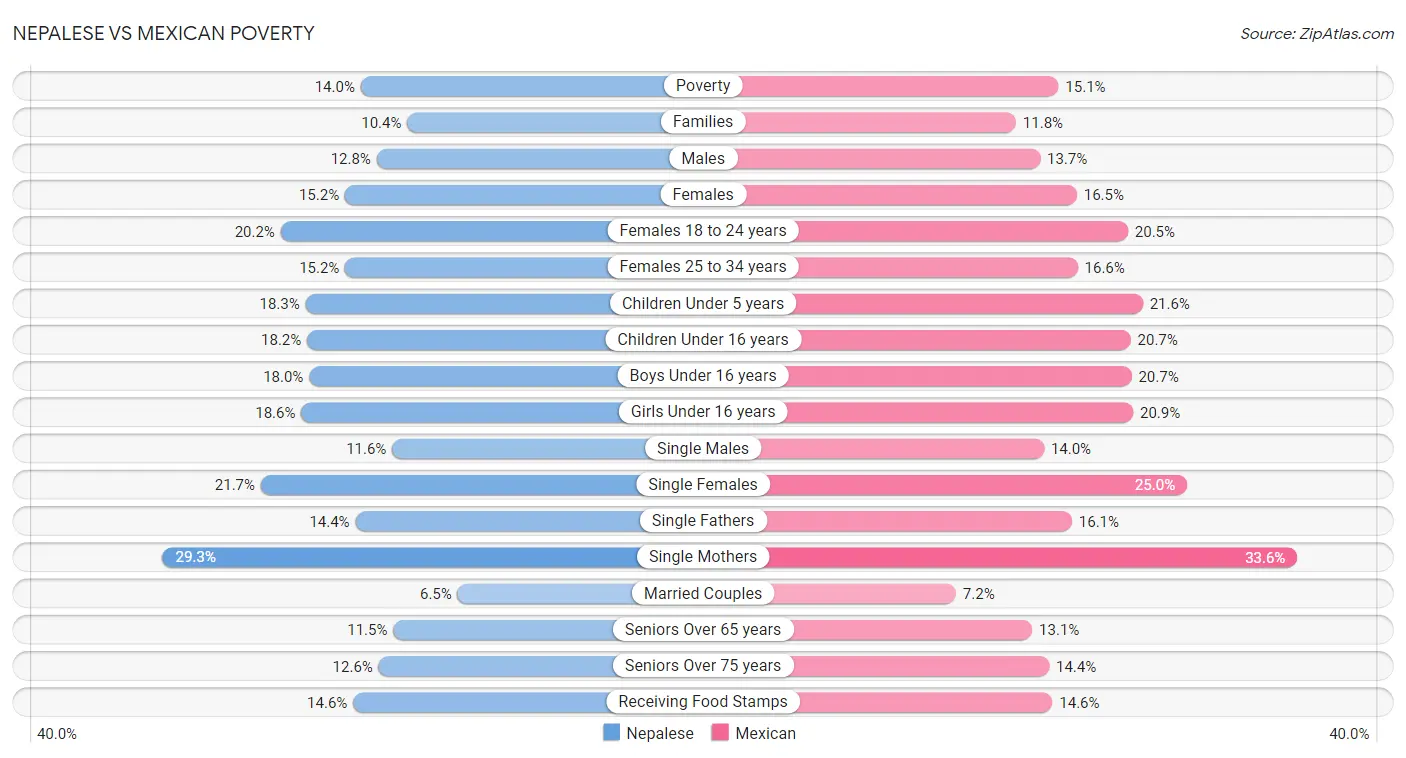
| Poverty Metric | Nepalese | Mexican |
| Poverty | Tragic 14.0% | Tragic 15.1% |
| Families | Tragic 10.4% | Tragic 11.8% |
| Males | Tragic 12.8% | Tragic 13.7% |
| Females | Tragic 15.2% | Tragic 16.5% |
| Females 18 to 24 years | Fair 20.2% | Poor 20.5% |
| Females 25 to 34 years | Tragic 15.2% | Tragic 16.6% |
| Children Under 5 years | Tragic 18.3% | Tragic 21.6% |
| Children Under 16 years | Tragic 18.2% | Tragic 20.7% |
| Boys Under 16 years | Tragic 18.0% | Tragic 20.7% |
| Girls Under 16 years | Tragic 18.6% | Tragic 20.9% |
| Single Males | Exceptional 11.6% | Tragic 14.0% |
| Single Females | Tragic 21.7% | Tragic 25.0% |
| Single Fathers | Exceptional 14.4% | Good 16.1% |
| Single Mothers | Fair 29.3% | Tragic 33.6% |
| Married Couples | Tragic 6.5% | Tragic 7.2% |
| Seniors Over 65 years | Tragic 11.5% | Tragic 13.1% |
| Seniors Over 75 years | Poor 12.6% | Tragic 14.4% |
| Receiving Food Stamps | Tragic 14.6% | Tragic 14.6% |
Nepalese vs Mexican Unemployment
When considering unemployment, the most significant differences between Nepalese and Mexican communities in the United States are seen in unemployment among women with children ages 6 to 17 years (7.7% compared to 9.3%, a difference of 20.6%), unemployment among ages 65 to 74 years (5.0% compared to 5.8%, a difference of 15.7%), and unemployment among women with children under 6 years (7.7% compared to 8.9%, a difference of 15.6%). Conversely, both communities are more comparable in terms of unemployment among ages 60 to 64 years (5.2% compared to 5.2%, a difference of 0.050%), unemployment among ages 25 to 29 years (7.5% compared to 7.5%, a difference of 0.13%), and unemployment among ages 20 to 24 years (10.6% compared to 10.6%, a difference of 0.44%).
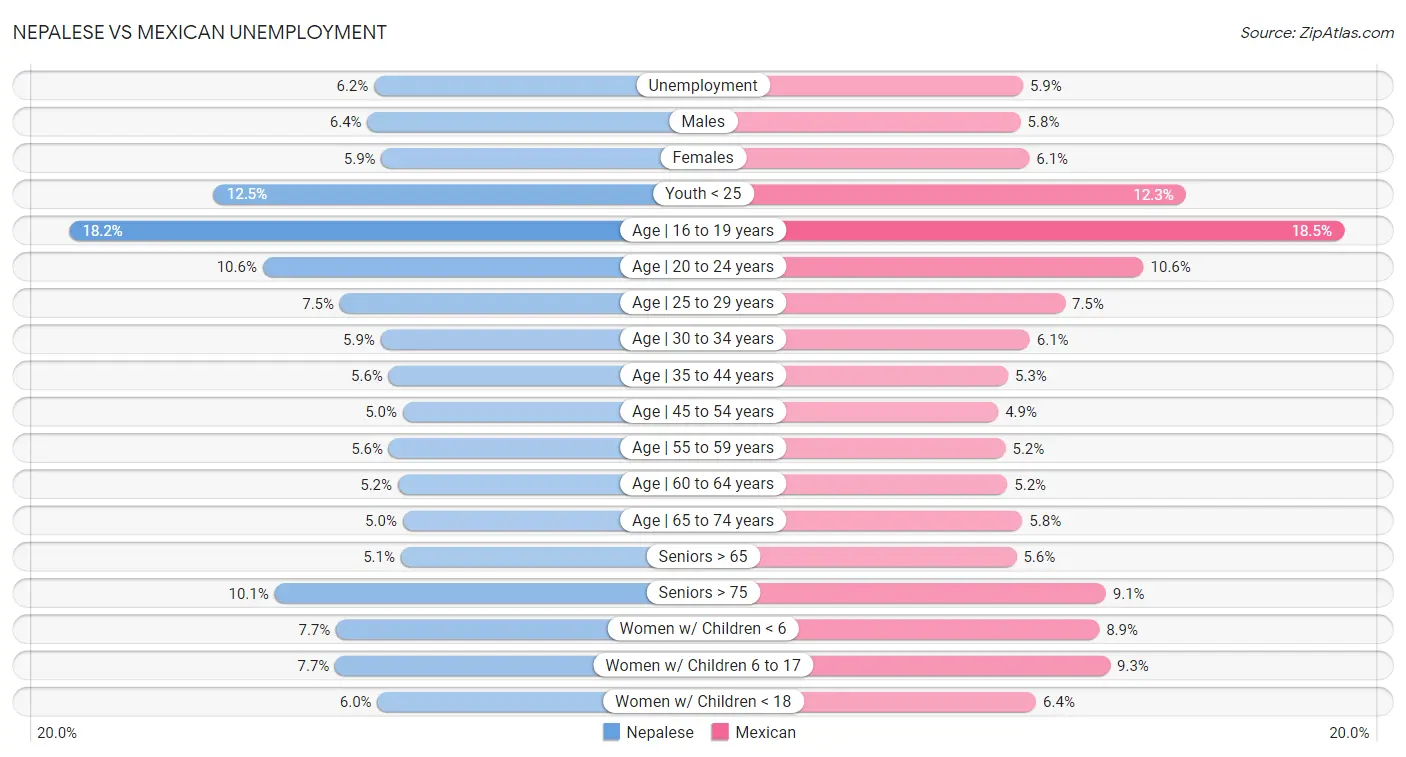
| Unemployment Metric | Nepalese | Mexican |
| Unemployment | Tragic 6.2% | Tragic 5.9% |
| Males | Tragic 6.4% | Tragic 5.8% |
| Females | Tragic 5.9% | Tragic 6.1% |
| Youth < 25 | Tragic 12.5% | Tragic 12.3% |
| Age | 16 to 19 years | Tragic 18.2% | Tragic 18.5% |
| Age | 20 to 24 years | Tragic 10.6% | Tragic 10.6% |
| Age | 25 to 29 years | Tragic 7.5% | Tragic 7.5% |
| Age | 30 to 34 years | Tragic 5.9% | Tragic 6.1% |
| Age | 35 to 44 years | Tragic 5.6% | Tragic 5.3% |
| Age | 45 to 54 years | Tragic 5.0% | Tragic 4.9% |
| Age | 55 to 59 years | Tragic 5.6% | Tragic 5.2% |
| Age | 60 to 64 years | Tragic 5.2% | Tragic 5.2% |
| Age | 65 to 74 years | Exceptional 5.0% | Tragic 5.8% |
| Seniors > 65 | Good 5.1% | Tragic 5.6% |
| Seniors > 75 | Tragic 10.1% | Tragic 9.1% |
| Women w/ Children < 6 | Average 7.7% | Tragic 8.9% |
| Women w/ Children 6 to 17 | Exceptional 7.7% | Tragic 9.3% |
| Women w/ Children < 18 | Tragic 6.0% | Tragic 6.4% |
Nepalese vs Mexican Labor Participation
When considering labor participation, the most significant differences between Nepalese and Mexican communities in the United States are seen in in labor force | age 16-19 (33.5% compared to 35.6%, a difference of 6.4%), in labor force | age 25-29 (82.9% compared to 81.9%, a difference of 1.2%), and in labor force | age 35-44 (82.4% compared to 81.6%, a difference of 0.99%). Conversely, both communities are more comparable in terms of in labor force | age 20-64 (77.5% compared to 77.2%, a difference of 0.38%), in labor force | age > 16 (63.8% compared to 64.1%, a difference of 0.40%), and in labor force | age 20-24 (74.5% compared to 75.1%, a difference of 0.82%).

| Labor Participation Metric | Nepalese | Mexican |
| In Labor Force | Age > 16 | Tragic 63.8% | Tragic 64.1% |
| In Labor Force | Age 20-64 | Tragic 77.5% | Tragic 77.2% |
| In Labor Force | Age 16-19 | Tragic 33.5% | Poor 35.6% |
| In Labor Force | Age 20-24 | Poor 74.5% | Average 75.1% |
| In Labor Force | Age 25-29 | Tragic 82.9% | Tragic 81.9% |
| In Labor Force | Age 30-34 | Tragic 82.7% | Tragic 81.9% |
| In Labor Force | Age 35-44 | Tragic 82.4% | Tragic 81.6% |
| In Labor Force | Age 45-54 | Tragic 80.5% | Tragic 79.8% |
Nepalese vs Mexican Family Structure
When considering family structure, the most significant differences between Nepalese and Mexican communities in the United States are seen in births to unmarried women (33.5% compared to 36.9%, a difference of 10.1%), single mother households (7.5% compared to 8.0%, a difference of 6.8%), and single father households (3.1% compared to 3.0%, a difference of 4.8%). Conversely, both communities are more comparable in terms of currently married (44.7% compared to 45.2%, a difference of 0.92%), average family size (3.42 compared to 3.48, a difference of 1.6%), and divorced or separated (12.5% compared to 12.2%, a difference of 2.3%).

| Family Structure Metric | Nepalese | Mexican |
| Family Households | Exceptional 67.2% | Exceptional 69.0% |
| Family Households with Children | Exceptional 30.5% | Exceptional 31.4% |
| Married-couple Households | Poor 45.6% | Excellent 47.1% |
| Average Family Size | Exceptional 3.42 | Exceptional 3.48 |
| Single Father Households | Tragic 3.1% | Tragic 3.0% |
| Single Mother Households | Tragic 7.5% | Tragic 8.0% |
| Currently Married | Tragic 44.7% | Tragic 45.2% |
| Divorced or Separated | Tragic 12.5% | Fair 12.2% |
| Births to Unmarried Women | Tragic 33.5% | Tragic 36.9% |
Nepalese vs Mexican Vehicle Availability
When considering vehicle availability, the most significant differences between Nepalese and Mexican communities in the United States are seen in no vehicles in household (7.4% compared to 7.0%, a difference of 5.2%), 4 or more vehicles in household (8.7% compared to 8.9%, a difference of 2.2%), and 3 or more vehicles in household (24.9% compared to 24.7%, a difference of 0.87%). Conversely, both communities are more comparable in terms of 2 or more vehicles in household (61.4% compared to 61.7%, a difference of 0.42%), 1 or more vehicles in household (92.6% compared to 93.0%, a difference of 0.44%), and 3 or more vehicles in household (24.9% compared to 24.7%, a difference of 0.87%).

| Vehicle Availability Metric | Nepalese | Mexican |
| No Vehicles Available | Exceptional 7.4% | Exceptional 7.0% |
| 1+ Vehicles Available | Exceptional 92.6% | Exceptional 93.0% |
| 2+ Vehicles Available | Exceptional 61.4% | Exceptional 61.7% |
| 3+ Vehicles Available | Exceptional 24.9% | Exceptional 24.7% |
| 4+ Vehicles Available | Exceptional 8.7% | Exceptional 8.9% |
Nepalese vs Mexican Education Level
When considering education level, the most significant differences between Nepalese and Mexican communities in the United States are seen in professional degree (3.2% compared to 2.7%, a difference of 17.7%), no schooling completed (3.8% compared to 3.3%, a difference of 15.5%), and college, under 1 year (62.2% compared to 55.6%, a difference of 11.8%). Conversely, both communities are more comparable in terms of 5th grade (95.2% compared to 95.2%, a difference of 0.030%), 4th grade (95.5% compared to 95.6%, a difference of 0.13%), and 6th grade (94.9% compared to 94.6%, a difference of 0.24%).
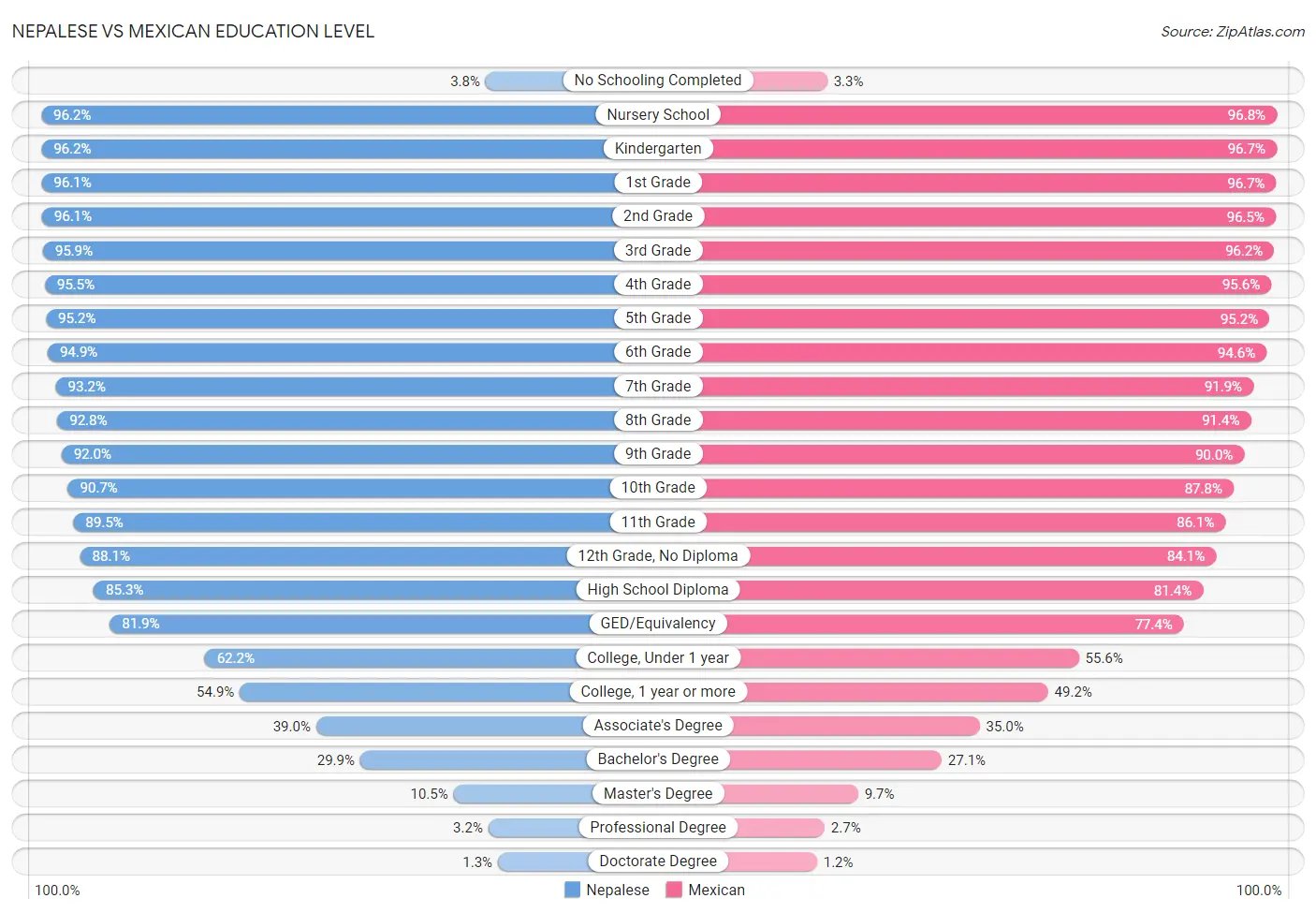
| Education Level Metric | Nepalese | Mexican |
| No Schooling Completed | Tragic 3.8% | Tragic 3.3% |
| Nursery School | Tragic 96.2% | Tragic 96.8% |
| Kindergarten | Tragic 96.2% | Tragic 96.7% |
| 1st Grade | Tragic 96.1% | Tragic 96.7% |
| 2nd Grade | Tragic 96.1% | Tragic 96.5% |
| 3rd Grade | Tragic 95.9% | Tragic 96.2% |
| 4th Grade | Tragic 95.5% | Tragic 95.6% |
| 5th Grade | Tragic 95.2% | Tragic 95.2% |
| 6th Grade | Tragic 94.9% | Tragic 94.6% |
| 7th Grade | Tragic 93.2% | Tragic 91.9% |
| 8th Grade | Tragic 92.8% | Tragic 91.4% |
| 9th Grade | Tragic 92.0% | Tragic 90.0% |
| 10th Grade | Tragic 90.7% | Tragic 87.8% |
| 11th Grade | Tragic 89.5% | Tragic 86.1% |
| 12th Grade, No Diploma | Tragic 88.1% | Tragic 84.1% |
| High School Diploma | Tragic 85.3% | Tragic 81.4% |
| GED/Equivalency | Tragic 81.9% | Tragic 77.4% |
| College, Under 1 year | Tragic 62.2% | Tragic 55.6% |
| College, 1 year or more | Tragic 54.9% | Tragic 49.2% |
| Associate's Degree | Tragic 39.0% | Tragic 35.0% |
| Bachelor's Degree | Tragic 29.9% | Tragic 27.1% |
| Master's Degree | Tragic 10.5% | Tragic 9.7% |
| Professional Degree | Tragic 3.2% | Tragic 2.7% |
| Doctorate Degree | Tragic 1.3% | Tragic 1.2% |
Nepalese vs Mexican Disability
When considering disability, the most significant differences between Nepalese and Mexican communities in the United States are seen in disability age under 5 (0.97% compared to 1.3%, a difference of 31.3%), self-care disability (3.0% compared to 2.7%, a difference of 10.7%), and disability age 5 to 17 (5.3% compared to 5.8%, a difference of 9.3%). Conversely, both communities are more comparable in terms of cognitive disability (18.0% compared to 17.8%, a difference of 0.84%), disability age over 75 (52.6% compared to 51.1%, a difference of 2.9%), and male disability (12.2% compared to 11.8%, a difference of 3.0%).
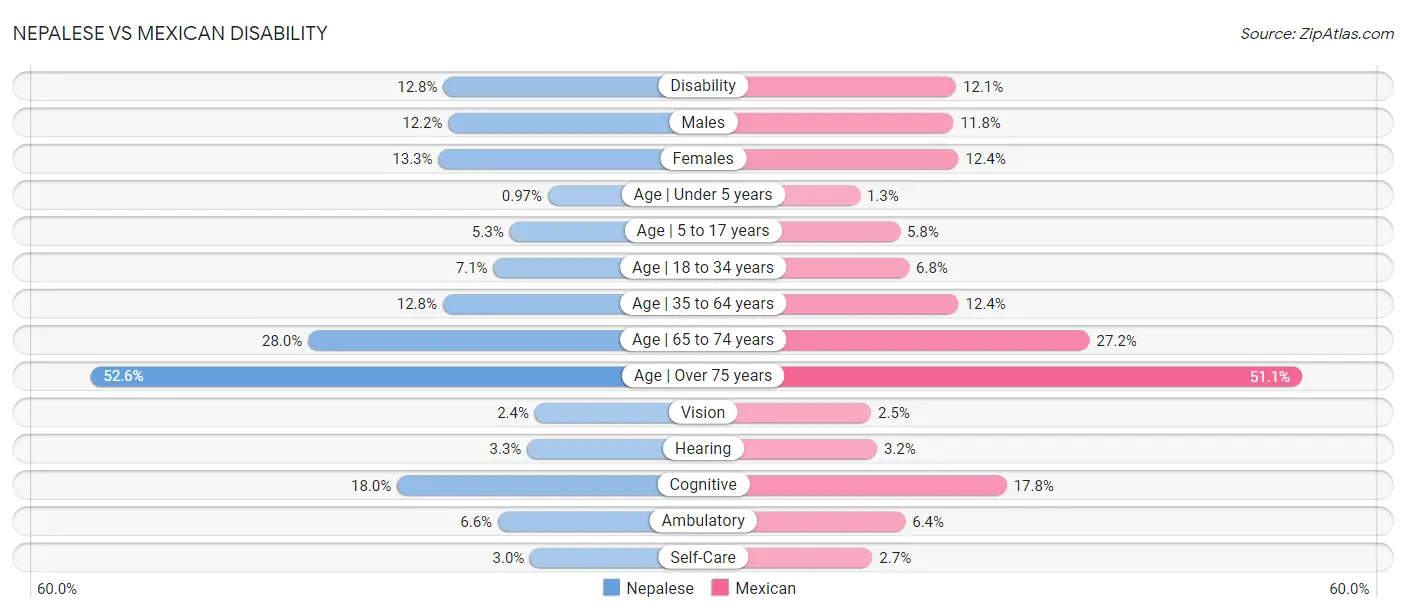
| Disability Metric | Nepalese | Mexican |
| Disability | Tragic 12.8% | Tragic 12.1% |
| Males | Tragic 12.2% | Tragic 11.8% |
| Females | Tragic 13.3% | Poor 12.4% |
| Age | Under 5 years | Exceptional 0.97% | Fair 1.3% |
| Age | 5 to 17 years | Exceptional 5.3% | Tragic 5.8% |
| Age | 18 to 34 years | Tragic 7.1% | Poor 6.8% |
| Age | 35 to 64 years | Tragic 12.8% | Tragic 12.4% |
| Age | 65 to 74 years | Tragic 28.0% | Tragic 27.2% |
| Age | Over 75 years | Tragic 52.6% | Tragic 51.1% |
| Vision | Tragic 2.4% | Tragic 2.5% |
| Hearing | Tragic 3.3% | Tragic 3.2% |
| Cognitive | Tragic 18.0% | Tragic 17.8% |
| Ambulatory | Tragic 6.6% | Tragic 6.4% |
| Self-Care | Tragic 3.0% | Tragic 2.7% |